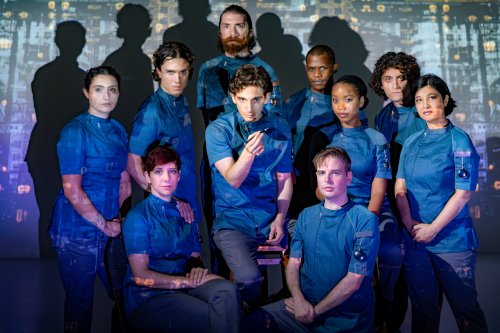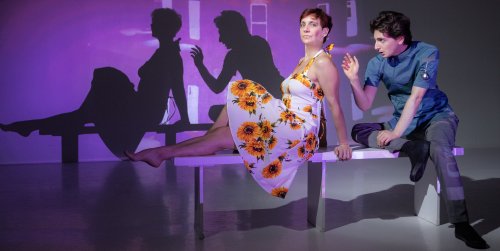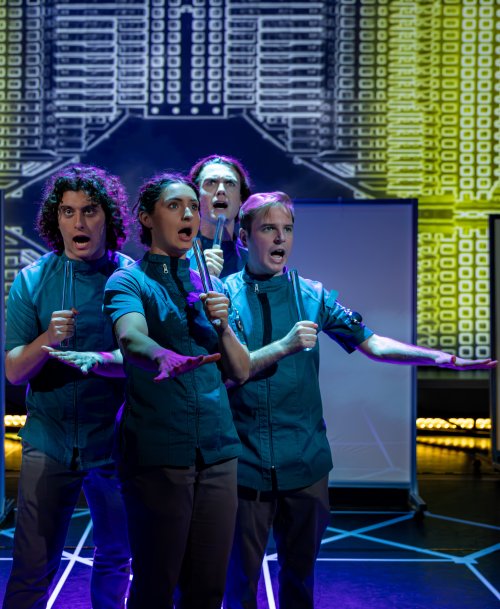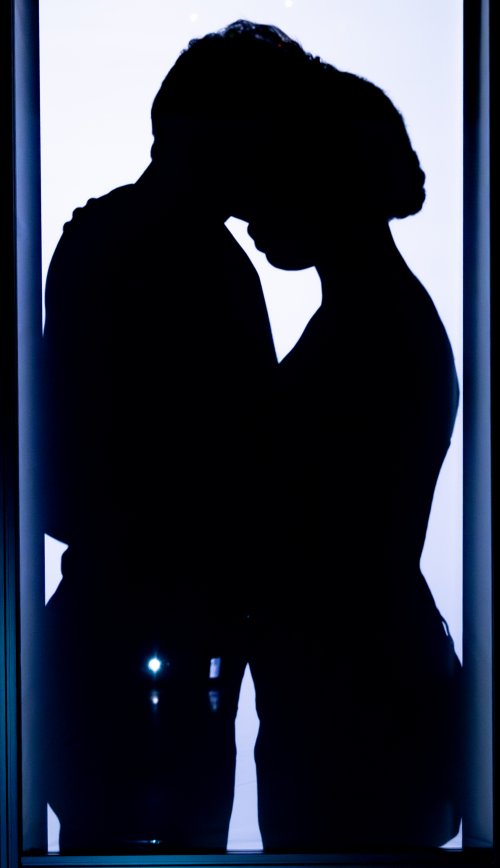
(Photo credit: Jonathan Levin)
By: Darryl Reilly
“Dreaming is a serious mental disease, a death sentence, a form of epilepsy.” So, observes the hero of the futuristic WE; it is a theatrically ravishing adaptation of Russian author Yevgeny Zamyatin’s (1884-1937) novel which was written from 1920 to 1921, and published in English in 1924. Its dystopia foreshadows the works of Aldous Huxley, George Orwell and Ray Bradbury.
Playwright Kevin Ray’s artfully faithful treatment of Zamyatin’s book was devised in collaboration with WE’s cast and its production designers. Mr. Ray’s virtuoso direction is of brisk pacing, euphoric movement sequences, captivating performances and grand stagecraft, resulting in an absorbing spectacle.

(Photo credit: Jonathan Levin)
In the 26th century after revolutions, the world has settled into a pseudo-Utopian “One State” where individuality is a thing of the past. Communal society is ruled by a Benefactor and Guardians; everyone wears the same uniform, people have numbers instead of names, sex is arranged by “pink checks” for “special appointments,” alcohol and tobacco are banned, there are frequent medical examinations, having a soul is a crime, violators of these strictures are brutally executed. Due to the indestructible human spirit, a resistance movement has arisen.

With his melodious voice, lithe physicality, striking facial features and commanding stage presence, Aaron Greenberg has the bearing of a classical actor as WE’s lead character, D-503. Mr. Greenberg is simultaneously amusing, soulful and heroic, as a foremost architect designing and constructing a high-powered flight vehicle. The alluring and honey-voiced Sabra Shelly is bewitching and beguiling with her vivacious performance as D-503’s smoking and imbibing femme fatale superior who seduces and then recruits him into the resistance. Wide-eyed and passionate Cassandra Umaña is entrancing as D-503’s quasi-love interest whose poignant and illegal goal is to have a baby. Playing a variety of archetypal science fiction-type figures is a dynamic ensemble; Sangita Baruah, Ian Cramer, Jonathan Nathaniel Dingle-El, Rachel Fink, Crosby Lloyd, Nathan Reder, Sabra Shelly, and John Teresi, all create vivid characterizations for their pronounced roles.

Lucite furnishings, crisscrossing white floor marks, a bust of Pushkin, a vintage world globe, and wheeled wall panels, are among the disparate choice elements of Yang Yu’s ingenious and aesthetic scenic and props design. Metropolis-style whirring gears, stunning cityscapes, sprawling vistas and ominous imagery, are the hallmarks of Matthew Deinhart’s mesmerizing projection design. Sex and violence are suggestively rendered by Deb Hertzberg’s haunting shadow puppet direction and design. Lighting designer Brian Aldous strategically veers from grainy dimness to textured brightness, achieving a queasy shape of things to come dimension. Composer Ian McNally’s eerie original music, along with ambient tones and requisite effects are beautifully realized by Robert A. K. Gonyo’s vigorous sound design. Costume designer Alyssa Korol’s lustrous blue shirts and gray slacks are ideal. Production Stage Manager Henry Menestrier masterfully oversaw the performance under review.

A former Bolshevik, Yevgeny Zamyatin became one of the first Soviet dissidents for satirizing national conformity in WE and other works; he eventually went into exile, dying poverty-stricken in Paris. This remarkable stage incarnation of WE, affirms its lasting power, influence, and sadly its timelessness, especially in light of the current world scene.
WE (through October 20, 2024)
KEVIN RAY | WORKS
The Mark O’Donnell Theater, 160 Schermerhorn Street, in Brooklyn
For tickets, visit www.kevinrayworks.com
Running time: two hours and 30 minutes including one intermission

Terrific production! I saw it on opening night.